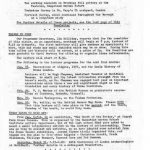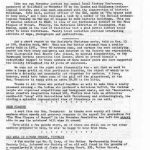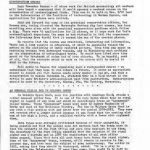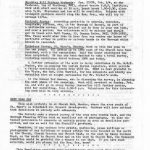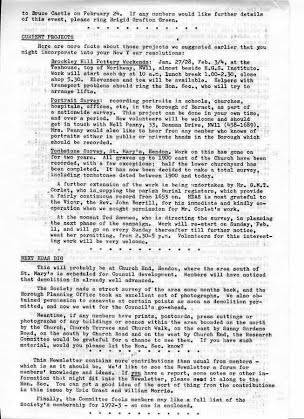
Page 1
First, may the Newsletter which all its readers a happy and fortunate 1973? And, as an afterthought, may it suggest a New Year resolution for members? Please resolve to help this year as actively as you can on one of the Society’s projects – for instance, helpers will be most welcome for the following: –
To working weekends on Brockley Hill pottery at the Teahouse, Hampstead Garden suburb.
Tombstone Survey in St. Mary’s Churchyard, Hendon.
Portrait survey, which continues throughout the Borough has a long-term study.
For further details of these projects, see the last page of this newsletter.
Things to come
Our Programme Secretary, Liz Holliday, reports that for the remainder of this winter, as an experiment, meetings will begin at 8.00p.m. instead of a 8.15 as hitherto. The first half-hour will give members an opportunity to meet, talk and study any small exhibits which may be on show. During this time, coffee and biscuits will be served, at a price of 5p; the Committee are most grateful to Carol Norbury for offering to organise these refreshments. The lecture will start at 8.30.
The following is the lecture programme for the next four months: –
January 16th. Excavations at Aldgate, 1972, and Early History of Roman London.
The lecturer will be Hugh Chapman, Assistant Curator at Guildhall Museum. We shall get the latest information straight from the horse’s mouth, as Mr Chapman was engaged last year on important excavations which throw a new and significant light on the foundation and early history of Roman Londinium.
20 February. R. J. Mercer of the British Museum on prehistoric excavations at Carnbrae, Redruth, Cornwall.
March 20. Dennis Hazelgrove, on the Fulham Potteries.
April 10. Dr. Wallis, on th British Museum Map Room. Please note that this lecture will take place on the second, not the third Tuesday of the month to avoid Holy Week.
Other dates to note
From 6 January to 11 February an exhibition, “The Craft of the Potter,” at Church Farm House Museum. This is organised by the Hampstead Garden Suburb Institute, Pottery Department, but at the last moment HADAS were asked to mount a small introductory exhibit on the history of pottery making. There was no time to collect new exhibits, so we have had that to some material from the Roman Hendon exhibition. Jeremy Clynes kindly organised this, and thanks are due also to five other helpers – Christine Arnott, Freda Wilkinson, Philippa Bernard, Raymond Lowe and Ted Sammes.
Saturday March 31st. 2.15-6.00: 10th Conference of London Archaeologists at Guildhall. Further details is a subsequent Newsletter.
Things Past
Daphne Lorimer has sent this report: on 21 November Mr James Lee fascinated a disappointingly small audience with an account of his work at the GLC. It is their mammoth task to record every historic building within their boundaries, to protect threatened a buildings and to persuade the Department of the Environment to issue protection orders where necessary. It is also the function of the GLC contract division to restore and maintain historic buildings within into your seat.
Page 2
Mr Lee explained on the mechanics of scheduled buildings and showed numbers of fascinating slides from the Department’s archives. Included were pictures of East Finchley’s Hawthorndene, a unique fire-proofed building which has recently been saved from demolition, Peacock’ farm and Southwark Borough High Street, whose plan is medieval and whose architecture is Georgian.
It is reassuring to know that authority is not always blind to beauty and to the relics of the past.
Local History Conference
Like our own November lecture, the annual Local History Conference, sponsored at Guildhall by the London and Middlesex Archaeological Society, was also much concerned with the conservation of historic buildings. John Earl, another officer of the GLC, spoke on “The urgent need to know more”, and there followed a talk by a member of the Enfield Archaeological Society on the use of plaques to mark historic buildings. This was of special interest to HADAS, in view of our forthcoming booklet on the Blue Plaques of Barnet. Finally, the Reference Librarian of Kensington, Miss Ensing, spoke on the kind of facilities that a good public library could offer to local historians. Twenty local societies provided interesting exhibits of maps, photographs and publications.
Christmas Party
And a short report on the Society’s Christmas Party, held on December 15th at 166 Station Road, NW4: this was far better attended than a similar party held in 1971. Over 50 members came, and perhaps the most satisfying aspect was that every age group and interest in the Society was represented, from11 year old Paul Beevor (who joined, by special dispensation, on the Burroughs Gardens excavation last summer, where he proved himself a redoubtable digger) to those members of more senior years who have supported the Society through its 12 years in existence.
We came out on the right side financially too – not that we want to make a large profit on this particular function, the object of which is to provide a friendly and seasonable get-together for members. A loss, however, would have taken some of the gilt off the gingerbread, so the Hon. Treasurer is happy with an extra £4.60 in the kitty.
Thanks to all those who pulled together so well to make this a really pleasant evening – the ladies who produced a delicious buffet, the various people who organised competitions and background music, and our “decorators” whose creative imagination turned 166 Station Road into an attractive candle-lit “snug” with decorations both Christmassy and archaeological, including a splendid impressionist view of Stonehenge on one wall.
Blue Plaques
A word from our Hon. Treasurer: he thanks most warmly those members whose speedy and generous response to the appeal for guarantors for “The Blue Plaques of Barnet” in the November Newsletter has left him almost able to pay the printer’s bill when it comes.
He is still a few pounds short, so if there are still one or two other members prepared to help, he will be happy to hear from you.
Old Well in Nether Street, Finchley
A few months ago, Mr. E. Levy, of the Nether Co-ownership Housing Society Ltd., informed the Society of an old well found in the grounds of a recently-built block of flats at Norman Court, 395 Nether Street, Finchley, and asked us along to inspect it.
The measure depth of the well was 3.53 metres, with water taking up 3 metres of this, with a further unknown depth of mud and rubble.
The mouth of the well is of interesting construction, as it is dome-shaped, the narrowest diameter at the mouth being 55 cm. This widens to 145 cm at a depth of 66 cm from the rim. This dome is constructed of narrow yellow bricks, but it was difficult to ascertain if the well below the water surface was built of brick or stone. The appearance was further confused by the later insertion of a ground drain into the side of the well, and the inside showed signs of dementing (? cementing) over in some parts.
Page 3
It is of course difficult to date wells. A large Victorian house occupied the land before the flats were built, so the well may have been associated with that house. The style of brickwork, however, suggests that it is older, and in fact the main body of the well below the dome could be any age. The well, after recording, has now been covered over prior to landscaping the grounds. (Notes contributed by Eric Grant)
Conservation Course
Last November Rescue – of whose work for British Archaeology all members will have heard – announced that it would sponsor a weekend course on the conservation of archaeological finds. This was to be held on Dec 9/10 in the laboratories of the Institute of Archaeology in Gordon Square, and applications for places were invited.
HADAS put forward the name of its principle conservation offices, Ted Sammes who, having directed the Burroughs Gardens dig last summer, has been wrestling ever since with the practical conservation problems which follow a dig. There were 45 applications for 12 places, so it says much for Ted’s archaeological experience (he says he had virtually to tell the organisers his life story from birth) that it earned him one of the coveted places.
He reports that the course was practical, interesting and informative. There was a long session on adhesives, of which he specially valued the advice on the unsticking of badly restored pottery. Some time was spent restoring bronzes from submerged vessels, and in discussing such problems as the conservation of waterlogged boats. He would have liked more time spent on the treatment of coins and of iron objects. He is hopeful, most of all, that the contacts which he made on the course will be useful to HADAS in the future.
Full marks to Rescue for organising such a much-needed course – we understand that they hope to run others in the future. It seems an appropriate moment to remind you that Rescue needs every member it can get, and that subscription to Rescue (minimum £1, students 50p) is a blow struck in the battle to save Britain’s archaeological past from destruction. Subscriptions should be sent to the Secretary of Rescue.
An unusual Pillar box in Golders Green
In Golders Green Road, near its junction with Armitage Road, stands a rather unusual pillar box. It is one of the rare boxes which bear no cipher or legend of any kind and which are accordingly known as “anonymous” pillar boxes. These “anonymous” boxes were made by Andrew Handyside of Derby and cast in his Britannia Foundry. The box in Golders Green Road is one with a high posting slot and dates from the period 1879-1883. They were not erected over a longer period because it was found that the posting slot was at too high a level, and a modified variety with a lower slot replaced them.
Both types were criticised because of their anonymity, it being pointed out that the public were not certain that the boxes were in fact the property of the Post Office, and were thus hesitant to use them. The Secretary of the Post Office admitted that the omission of the Royal cipher was a mistake and in 1887 the manufacture of all such pillar boxers was ceased. Since that date all post boxes have borne the Royal cipher. Some of the “anonymous” boxes, however, still remain in active service to the present day, and have been the subject of controversy. One critic in 1927, asking that they should be destroyed, added: “It is a pity to prepare for the Bolshevists. If ever they came, they ought to be left to clear away the Royal signs for themselves”. (Contributed by William Morris)
Tailpiece – in case readers don’t know, a North London museum has one of the best postal history collections in the country – Bruce Castle, in Lordship Lane, Tottenham. It is well worth visiting for many reasons, being the official museum of the Middlesex Regiment, as well as an important late Elizabethan manor house in its own right. The London and Middlesex Archaeological Society, to which our Society is affiliated, is organising a visit to Bruce Castle on February 24th. Of any members would like further details of this event, please ring Brigid Grafton Green.
Page 4
Current Projects
Here are more facts about those projects we suggested earlier that you might incorporate into your New Year resolutions:
Brockley Hill Pottery Weekends
Jan 27/8, Feb ¾ at the Teahouse, top of Northway, NW11 almost beside H.G.S Institute. Work will start each day at 10 a.m., lunch break 1.00-2.30, close shop 5.30. Elevenses and tea will be available. Helpers with transport problems should ring the Hon. Sec., who will try to arrange lifts.
Portrait Survey
Recording portraits in schools, churches, hospitals, offices, etc, in the Borough of Barnet, as part of a nationwide survey. This project can be done in your own time, and over a period. New volunteers will be welcome and should get in touch with Nell Penny. Mrs. Penny would also like to hear from any member who knows of portraits wither in public or private hands in the Borough which should be recorded.
Tombstone Survey, St. Mary’s Hendon
Work on this has gone on for two years. All graves up to 1900 east of the Church have been recorded, with a few exceptions; half the lower churchyard has been completed. It has now been decided to make a total survey, including tombstones dated between 1900 and today.
A further extension of the work is being undertaken by Mr. G. M. T. Corlet, who is copying the parish burial registers, which provide a fairly continuous record from 1653 on. HADAS is most grateful to the Vicar, the Rev. John Borrill, for his immediate and kindly co=operation when we sought permission for Mr. Corlet’s work.
At the moment, Ted Sammes, who is directing the survey, is planning the next phase of the campaign. Work will re-start on Sunday Feb. 11, and will go on every Sunday thereafter until further notice, weather permitting, from 2.30-5.00 p.m. Volunteers for this interesting work are very welcome.
HADAS Dig
This will probably be at Church End, Hendon, where the area south of St, Mary’s is scheduled for council development. Members will have noticed that demolition is already well advanced.
The Society made a street survey of the area some months back, and the Borough Planning Office took an excellent set of photographs. We also obtained permission to excavate to certain points as soon as demolition permitted and we now await the Council’s go-ahead.
Meantime, if any members have prints, postcards, press cuttings or photographs of any buildings or scenes within the area bounded on the north by the Church, Church Terrace and Church Walk, and in the east by Sunny Gardens Road, on the south by Church Road and in the west by Church End, the Research Committee would be grateful for a chance to see them. If you have such material, would you please let the Hon. Sec. know?
Newsletter contributions
This newsletter contains more contributions than usual from members – which is as it should be. We’d like to see the Newsletter a forum for members’ knowledge and ides. If YOU have a report, some notes or other information that might fit into the Newsletter, please send it along to the Hon. Sec. You can get a good idea of the sort of thing from the contributions in this issue by Eric Grant and William Morris.
Membership list
Finally, the Committee feels members may like a full list of the Society’s membership for 1972/3 – so one is enclosed.

